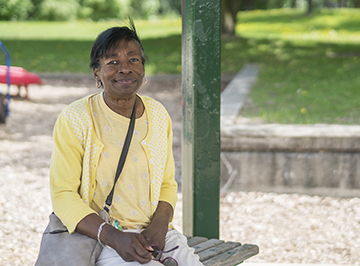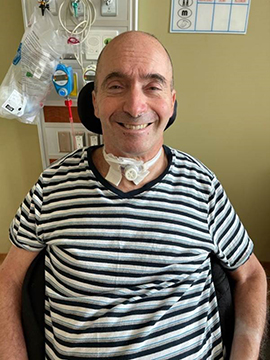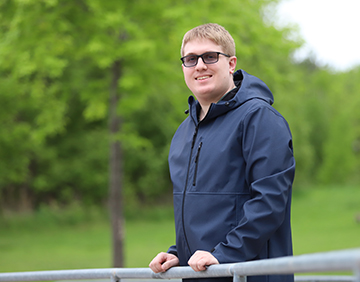May 29, 2022
At March of Dimes Canada, we’re committed to championing equity and empowering ability every week of the year. But National AccessAbility Week 2022 (NAAW) is an excellent opportunity to reflect on the many ways our programs and services empower people with disabilities to live and thrive in communities across the country.
To celebrate National AccessAbility Week 2022, we’re excited to share impactful stories
each day this week from our amazing clients.
Latest Stories
A chance to grow: Emily's story — The best start for children, youth and families
Striding forward: Elaine's story — Independence at home and in the community
Connecting to creativity: John’s story — Active, healthy, connected lives
The right career fit: Graham’s story — Financial security
Emily Ngai

“Emily lights up when she sees other kids doing the same thing as her.”
— Jenny Ng, Emily’s mom
and Conductive Education program participant
Emily Ngai is a happy eight-year-old, who loves music, cartoons, and playing with other kids. She also faces significant challenges as she grows up with multiple disabilities, including severe spastic quadriplegic cerebral palsy with dystonia, vision impairment, and a developmental delay. Emily is also non-verbal.
Yet, as Emily’s mom Jenny attests, she loves taking part in March of Dimes Canada’s (MODC) Conductive Education program. There, she gets to have fun, learn, and just be a kid. Emily’s been taking part in MODC’s program since she was less than a year old, helping her develop skills and gain confidence.
Emily enjoys a special bond with Monika Rumi, the lead instructor. “Emily can recognize Monika’s voice and loves to hear her sing,” says Jenny. “Monika is really good at creating activities that engage her.”
Monika helps Emily build independence through play-based activities, encouraging new ways of moving and strengthening her gross motor skills. For example, in one activity Monika encourages Emily to put her hands down on the mat and work to prop herself upright.
When they’re joining Conductive Education virtually, Jenny often places the monitor to the right of Emily, so that she needs to turn to see Monika. This helps strengthen her neck movement and increase her ability to use her augmentative communication device.
When it’s snack time, everyone eats together. “Eating has been a struggle. But Emily lights up when she sees other kids doing the same thing as her,” says Jenny. “It entices her to eat as well.”
Emily has made great strides, and so have her parents. Jenny says she feels a sense of community from being surrounded by other parents of kids living with disability. One of the most helpful things about the program is the positive mentality it fosters. She’s also encouraged to let Emily incorporate trying new things into her day-to-day life, like supporting Emily’s arm while she holds a towel to wipe her own face after eating.
“As Emily explores new skills, I’m often surprised,” says Jenny enthusiastically. “I tell her ‘I didn’t know you could do that!’”
Emily’s diagnosis means future challenges, but Jenny knows her daughter will use what she’s learned in MODC’s Conductive Education program for whatever lies ahead. “I want to ensure Emily can do the best she can,” explains Jenny. “That’s the main goal for all parents — to see their child reach their potential.”
Elaine Williams

“The first time I went, I was so overwhelmed emotionally. Right away, I felt that I belonged.”
— Elaine Williams,
MODC, Brain Injury Community Support Group participant
On her 50th birthday Elaine Williams experienced a stroke for the first time. The wife, mother of two, and former early childhood educator was at work when it happened. During the next three years, Elaine would survive five more strokes. The most significant one caused aphasia — a language disorder that has affected her speech.
“I had small girls when the first one happened, and I didn’t want to be a burden to them,” Elaine recalls. She knew she had to focus on recovery, for her family’s sake. “They’re what motivated me to get my act together.”
Along with wanting to be there for her family, as a social person Elaine was also determined to maintain her independence and avoid isolation. That’s why she was so excited when she discovered that March of Dimes Canada’s (MODC) Brain Injury Services offered a mall walking group in her community for people living with the effects of a brain injury including aphasia.
“The first time I went, I was so overwhelmed emotionally,” Elaine recalls fondly. “Right away, I felt that I belonged.” Here, Elaine made new connections and was able to overcome isolation. She was also able to help others, too. “If others in the group were having trouble with their aphasia and couldn’t find the right words, I was there, waiting patiently and encouraging them.”
The mall walking group was just the start for Elaine. Next, she discovered the Annual Brain Injury Survivor Conference, organized by MODC in collaboration with community partners. Engaging in the conference and making new friends has been a source of inspiration for Elaine on her journey to living a full life again.
“I saw people — just like me — who were struggling to lead a normal life,” she explains. “By attending year after year, I got to see their progress. And from there, I made friends. It’s been wonderful.”
Elaine had her first stroke 25 years ago. Today, she’s an active and independent 75-year-old retiree who’s enjoying life to the fullest. Elaine lives at home with her husband, travels to England on her own to visit relatives, and enjoys watercolour painting and reading.
And she’s still a member of her MODC mall walking group. While the group paused its activities to protect members from COVID-19, Elaine and her friends have recently started lacing up their walking shoes again. She couldn’t be happier about it.
“It’s like a shot in the arm, like a tonic,” she says. “We encourage each other. We joke with each other. We’re there for each other. I love it!”
John Hornstein

“The technology currently coming out is making it possible for people with disabilities to live their lives.”
— John Hornstein,
TELUS Tech for Good program recipient
Back in 2010, John Hornstein was an active and social person, who enjoyed connecting with family and friends. He loved making art in his spare time. That was until his spinal cord was crushed in a tragic cycling accident.
“After my injury, my girlfriend said I was moving my hands quite a bit, and waving my arms,” John says. But, within days, that movement stopped. The accident caused traumatic swelling of his stenotic spinal cord, killing the nerves between several vertebrae. John found himself hospitalized for a decade.
Today, assistive technology is enabling the 64-year-old to return to a productive, independent life. Thanks to a newly expanded partnership between March of Dimes Canada and TELUS’ Tech for Good Program, John’s been able to move from the hospital back home successfully.
Tech for Good offers individuals like John, who are living with disabilities, a personalized, virtual one-on-one assessment, customized recommendations, training, and support with mobile devices. The goal is to enable people with disabilities to live more independently.
“The technology currently coming out is making it possible for people with disabilities to live their lives,” he says.
With the support of an Assistive Technology Specialist, John has learned to use voice-controlled technology, like Siri or the Echo Dot (voice-controlled assistive devices), to access smart-home capabilities. “I can use my iPhone to turn on the lights, thermostat, computer, TV, and so on,” he says.
Access to technology has also dramatically improved his sense of community and safety. Prior to the support from Tech for Good, John had attempted moving home, but was unsuccessful—he couldn’t make calls to his support staff. But with a new Bluetooth earpiece, John — who is soft-spoken since undergoing a tracheotomy — is now able to communicate with voice-controlled personal assistants in his home, with friends, family, and support staff.
Access to technology has been transformative for John. Life before the smartphone and voice-assistants left him “more or less incommunicado. [He] found it very difficult not to be able to call people.” Now, when he’s not chatting with friends, John’s working to further his artistic aspirations via computer, and feeling very happy to be home.
Graham Conti

“Having financial security gives me a lot of peace of mind and comfort.”
— Graham Conti,
March of Dimes Canada Employment Services client
Graham Conti was in his first year of university when he decided to take a proactive approach to finding a career suiting his education, skills, and personality. But, as a person living with anxiety, Graham knew he needed help. When he discovered March of Dimes Canada’s (MODC) Employment Services, it felt like the right fit for his needs.
“When I came in and met the team, everyone was really friendly,” Graham recalls. “I thought it was a good environment. On top of that, they specialize in employment for people with barriers and disabilities, so I knew they would understand my situation and what I need,” he adds.
Living with anxiety meant Graham was eligible for the wide range of services MODC offers clients providing opportunities to explore career paths, seek meaningful employment, or transition into a new role. The MODC team assessed his skills, helped him develop his resume, introduced him to employers, and coached him for interviews — all while Graham was earning a Bachelor of Science in Chemistry degree.
In 2018, Graham graduated. Thanks to support from MODC Vocational Rehabilitation Specialist Kerri-Ann Rochon, in 2019 he landed the role of data-entry clerk. Since then, he’s since been promoted to account manager role with MySDS, a company that provides an online management system for safety data sheets. Graham helps keep employees and buildings safe by listing the ingredients, environmental health hazards, protective measures, and safety precautions associated with a wide variety of products and chemicals.
With his knowledge of chemistry, his attention to detail, and his exceptional memory, Graham’s a great fit for the role. One of his superpowers is ensuring the safety data sheets are accurate and up to date by comparing the names of chemical compounds that would look identical to most people. “I’m the go-to person when others have questions about chemicals,” he says proudly.
The two most rewarding aspects of Graham’s job are ensuring success for new clients and collaborating with his colleagues. But the icing on the cake? “Having financial security. It gives me a lot of peace of mind and comfort,” Graham says.
